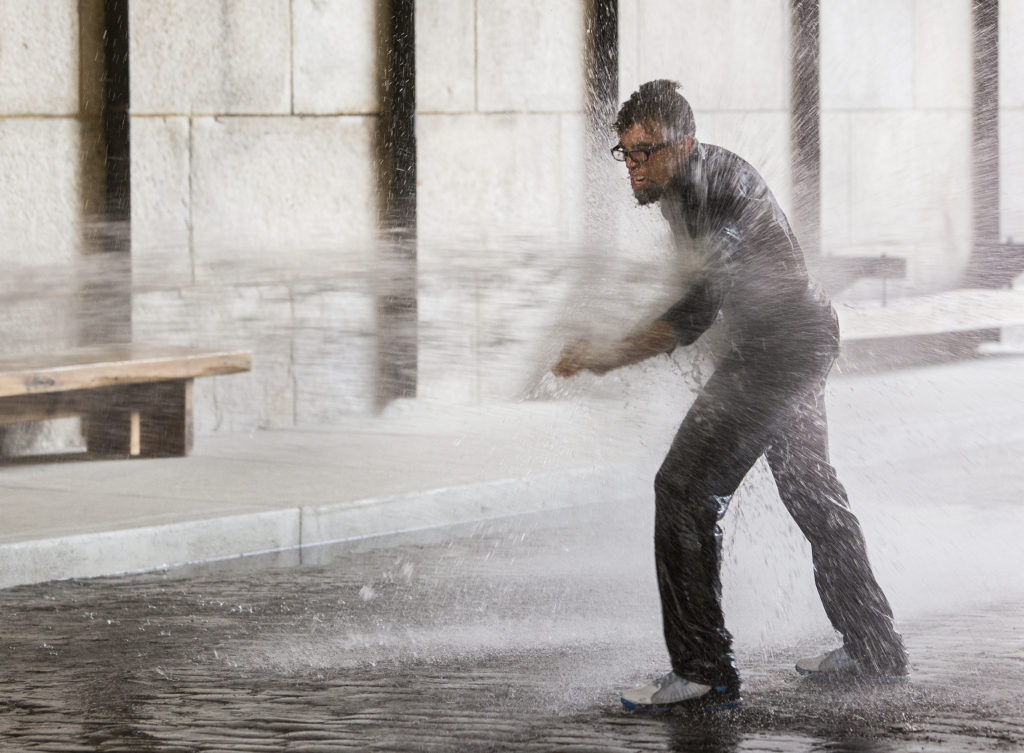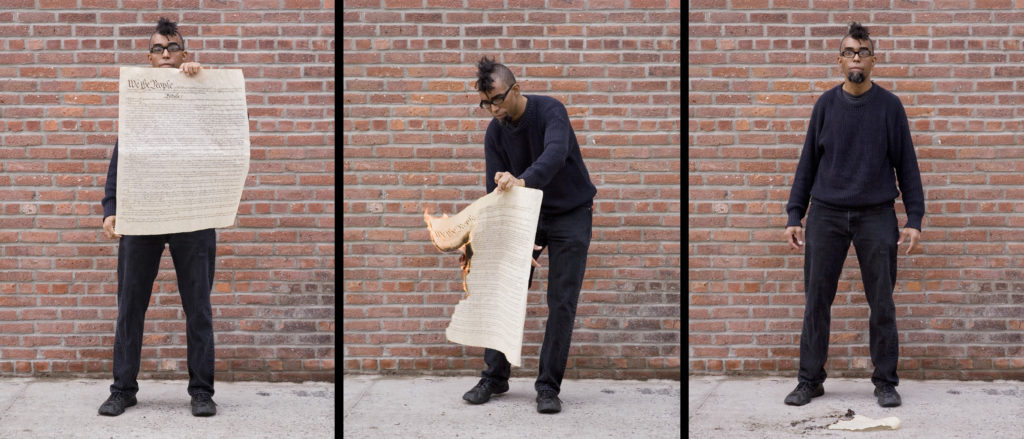
Dread Scott, On the Impossibility of Freedom in a Country Founded on Slavery and Genocide, performance still (1), pigment print, 22″ x 30,” 2014. Courtesy the artist.
In this issue, Dread Scott responds to questions about “who” is needed to make socially engaged art. Dread Scott makes revolutionary art to propel history forward, working in a range of media including performance, photography, screen printing, video, installation and painting. He has exhibited and performed at numerous institutions, including the Whitney Museum of American Art, the Contemporary Arts Museum Houston, the Walker Art Center, and Brooklyn Academy of Music, and has been written about in numerous publications including The New York Times, Art in America, ArtNews, Artforum, Art21 Magazine, The Guardian, and Time.
Dear Dread,
I’m half of Intelligent Mischief, a creative action lab that uses art, narrative, design, and pop culture to bring about social change. We do a lot of training and capacity-building with individual organizers and activist groups around creative direct action, artivism, and integrating imagination into cultural organizing. We’ve found that these activist groups are open to making their work more creative, but are often not able to make long-term commitments to incorporating art into their activism. Do you think it is possible to help organizing to be more creative, or should we focus on activating artists? Or both?
— Aisha Shillingford, Brooklyn, NY
Dear Aisha,
Thanks so much for your question. The short answer is “both.” Artists need to get out of the studios and join the struggle. And activist organizations need to be more creative in how they think about and initiate change.
If you and the artists/organizations you work with want to take on some of the big questions confronting humanity, then the artists need to learn from radical and progressive activists who have spent decades fighting to change the world. And the activists shouldn’t just continue what they’ve been doing without utilizing the strengths of artists.
For me, working with revolutionaries, being part of demonstrations, meeting people whose life experience is different than mine (including those who have lost loved ones to murdering cops), organizing activist meetings, being arrested, fighting legal battles, raising money to keep offices open and print flyers, studying communist theory—in short, being an activist—has made important contributions to changing the world, and has also greatly enriched my life and art. Artists who care about humanity would do well to connect with people who are “professional activists” and be part of movements. Many artists already do, but I encourage more to do so and to really go all in.
At the same time, many activist organizations don’t really understand art. Frequently, artists attempting to reach out and work with activist organizations are asked to paint a banner or do a fundraiser. Artists should paint some banners and raise funds, but what’s needed is beyond better-designed “End the XYZ” banners or a few thousand dollars. Some artists know about intervening in public space and how to shift the ways people think or ask questions. We are willing to attempt the impossible. Artists’ boldness of thought combined with activists’ determination and knowledge of key questions can produce magic.
It’s great that you’ve experienced organizations open to making their work more creative. If the art/artists genuinely enhance the effects of the activists, why can’t these organizations incorporate creativity into their work in an ongoing way? Emory Douglas reimagined design to serve the people when illustrating the Black Panther Newspaper. Laurie Jo Reynolds worked for a decade for the successful closure of Tamms C-Maxx prison. In these cases, artists and activists found ongoing ways for their work to strengthen shared goals.
For activists to see what creative vision can bring to the battles they are fighting will require repeated struggle, challenging some of their assumptions and methods. Working with artists can be messy and at times frustrating: some artists’ ideas will be bad or even harmful to the movements they support. Artists in turn must be open to assessing their work and methods in terms of how they serve the strategic goals of a movement. I encourage both artists and activists to consider the complexity of social change, and that art that engages the big questions confronting humanity can still serve the aims of broader movements even when the work is not necessarily directly part of the movement.
The problem you pose is not easy to solve. But when we get these partnerships right, art can deeply connect with people. If you continue to remind people what brought them together in the first place, together they change the world.
Dread

Dread Scott, Burning the US Constitution, 3 pigment prints, each print 26″ x 20,” 2011. Courtesy the artist.
Dear Dread,
As a white cis woman curator and artist, I am continually seeking out best practices for being in conversations and actions related to issues facing communities that are not my own. Though I prioritize perspectives and programming ideas from my community partners, and acknowledge them and emphasize their views when I am asked to speak or write about projects on which we collaborate, my current focus is in my home state of Montana, where less than 10% of residents are not white. These partners are often too busy doing the tough work, being leaders in their often disenfranchised, under-represented communities to respond to media or other inquiries or to seek funding, and I’ve ended up being the public face of these projects.
Guilt about privilege and a desire to avoid “do-gooder” frameworks certainly feed my uneasiness in this role, but mostly I question who I, as this public face, need to be to most effectively support these projects and communities and bring attention to issues that may not directly affect my life. How do I most respectfully define my identity and use my resources in public, when a partner of the affected community is unable or unavailable to stand with me?
— Sherri Cornett, Billings, MT
Hi Sherri,
Thanks for your question. I’m glad to hear that you are mindful of the systemic oppression that defines our society and world.
You have described yourself as a “white cis woman curator.” Your “guilt about privilege” is about whiteness, not about being a woman. Also, you have not explicitly addressed questions of class, but we’ll have to leave that for another time.
Get over your guilt. If you are genuinely helping people in the communities that you wish to work with, people will recognize this. And if you are well-intentioned but not well-practicing, people will see through the intent and judge you for your actions. I’m glad for the John Browns of the world and I have no use for the Ben Carsons. No person should mistake Sarah Huckabee Sanders as a fighter for women, though she is female. The real question is the ideas and actions, not identity. In a white supremacist society, people who are white have privilege through whiteness alone, and you will do a lot of harm if you don’t recognize this and fight against it. But when you understand this and seriously study, then you can transform your thinking and actions.
You say your partners are too busy to respond to media or to seek funding. But artists and community leaders make choices about how to spend their time. I’ve yet to meet a leader or artist who doesn’t have time for good funding or media opportunities. Ask yourself why the people you are working with don’t assess these opportunities the same way you do. If you feel the opportunities you see are a good fit and your partners should make time for them, struggle with them to make the time. To not do this may seem like it is helping them do the “tough work being leaders,” but actually it risks condescension. When you have this conversation, listen to their perspective. You may learn why these leaders think that a particular opportunity is not so good, or that it makes most sense for you to speak on behalf of your collaboration—in which case there’s no need to be guilty about doing it. Then when speaking, don’t define your identity in relation to a project as the “white woman curator,” but rather as the curator or collaborator or partner. It shouldn’t be about you and white privilege, but rather whatever the project is.
Finally, in all of America, including mostly white Montana, all people need art and ideas that challenge white supremacy (and patriarchy, capitalism, and American chauvinism/patriotism . . . ). Showing a lot of radical work of the 10% from your state is essential for overcoming centuries of oppression, even if it’s not representative of the demographic, and even if some people feel challenged by this. I hope that you continue to program this work.
Dread


